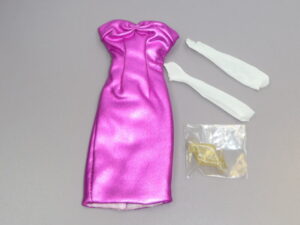 Your delicate and detailed vintage Barbie clothing is, by definition, generally decades old. This fact makes proper care essential to keeping these tiny fashion treasures looking their best. So, whether you’ve collected a single prized outfit or an entire closet’s worth of garments from across the decades, knowing how to clean, store, and repair these pieces helps protect your collection for years to come.
Your delicate and detailed vintage Barbie clothing is, by definition, generally decades old. This fact makes proper care essential to keeping these tiny fashion treasures looking their best. So, whether you’ve collected a single prized outfit or an entire closet’s worth of garments from across the decades, knowing how to clean, store, and repair these pieces helps protect your collection for years to come.
With a little attention and the right techniques, your vintage Barbie wardrobe can stay as beautiful as the day it was sewn. Here at Gigi’s Dolls and Sherry’s Teddy Bears, we want to help you do exactly that with some of the best advice we’ve picked up in our decades of experience in this field.
The Delicate Nature of Vintage Fabrics
Common Materials Used in Barbie Clothing
The vast majority of vintage Barbie outfits were made with real fabric, not plastic imitations. Depending on the era, that may include fine cotton, silk-like synthetics, velvet, lace, knits, or even metallic threads. These fabrics were carefully chosen to mimic adult fashion trends, but in miniature form, they are more fragile and less forgiving when exposed to stress or moisture.
In many cases, materials that seemed sturdy 50 or 60 years ago have begun to weaken with age. Elastic bands lose their ability to stretch, synthetic blends can stiffen or become brittle, and dyes may fade or run if exposed to water. Understanding these vulnerabilities is the first step in treating your collection gently.
Why Age Makes a Difference
Even the best-preserved outfits will be affected by time. Elasticized waistbands lose their shape, velvets flatten, and delicate trims can detach with little provocation. Some pieces may look sturdy but are beginning to weaken at the seams. If you have begun to notice fraying edges, threadbare areas, or yellowing fabric, it’s time to move from display to preservation. Handling vintage Barbie clothes carefully—avoiding tugging or overextending sleeves and pant legs—can help minimize wear, especially in older outfits that weren’t made to withstand repeated changes decades later.
Cleaning with Care
Spot Cleaning vs. Full Wash
Cleaning Barbie clothing can be a nuanced process. In general, full immersion washing should be avoided unless you’re absolutely certain the fabric won’t bleed or shrink. Spot cleaning is typically the safer option. Use a cotton swab or a soft cloth dampened with distilled water and dab gently, never scrub. A small drop of mild detergent can sometimes help with surface grime but be sure to test it on an inconspicuous area first. When it comes to stains on white fabrics, try placing the piece in indirect sunlight for a few hours, as this can naturally reduce yellowing without harsh chemicals.
Products to Avoid at All Costs
Bleach, alcohol, vinegar, and standard household cleaners should never be used on vintage Barbie clothing. These substances are too harsh and will damage the fabric or cause colors to bleed. Similarly, soaking garments in water—even plain water—can lead to stiffening, fraying, or distorted shapes. Velvets, knits, and metallic-thread garments are especially sensitive. If you’re unsure whether a fabric is safe to clean, it’s often better to leave it untouched or consult a professional with experience in doll clothing restoration.
Smart Storage Strategies
Avoiding Light, Heat, and Humidity
Sunlight is one of the most damaging elements to vintage fabrics. Even indirect light can fade colors and weaken fibers over time. Store Barbie outfits in a cool, dark, and dry environment. Do your best to avoid attics, basements, or closets that are near heating vents. Consistent temperature and humidity levels are best for preservation. If you choose to display your collection, consider using cases with UV-filtering glass and rotating outfits regularly to minimize exposure.
Using Archival Materials for Preservation
Proper storage can significantly extend the life of your Barbie clothing. Use acid-free tissue paper to pad and separate items. Garments can be stored flat in clear, divided boxes, or archival fabric folders. For smaller accessories like hats, purses, or shoes, compartmentalized containers keep items secure and organized. Labeling each section by era, outfit name, or collection theme makes it easier to retrieve what you need without over-handling pieces. It’s also wise to avoid plastic bags and tight containers as these can trap moisture.
Repairing Tears, Snaps, and Seams
When DIY Is Possible and When It’s Not
Minor repairs like reattaching a loose snap or stitching a small tear can often be done at home if you have a steady hand and the right materials. Use fine thread that closely matches the original and avoid over-stitching or making any visible knots. But when you’re dealing with rare outfits, fragile seams, or damage near detailed trims, it’s often best to trust the repair to someone with doll clothing experience. Repairs made with heavy thread or improper techniques can devalue an outfit or cause additional wear. That’s why Gigi’s Dolls and Sherry’s Teddy Bears offers Doll Hospital services that respect the craftmanship and sentimental value of your collection. Whether it’s mending a hem, replacing a missing detail, or refreshing a tired ensemble, we expertly handle each piece with care.
Preserving Integrity While Restoring Wear
The goal for any repair is to maintain the integrity of the piece while gently restoring its function. Repairs should blend in, not draw attention. Original materials should be preserved whenever possible, and any replaced pieces—like snaps or hooks—should reflect the style and scale of the original.
Here at Gigi’s Dolls and Sherry’s Teddy Bears, we have a large collection of Vintage Barbie doll, clothes, and accessories. In addition to selling you these treasures, we want to ensure you know how to best care for them. Contact us today if you’re interested in learning more!


